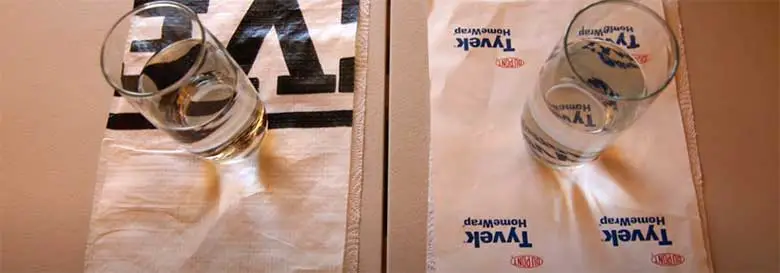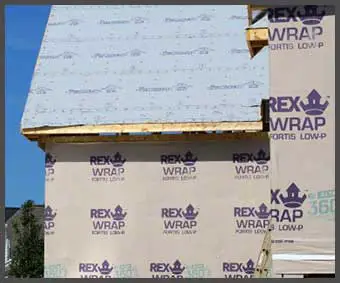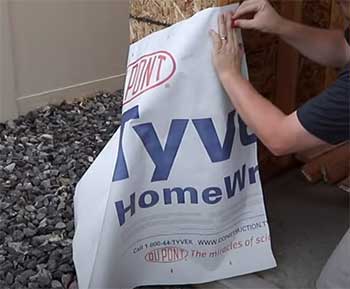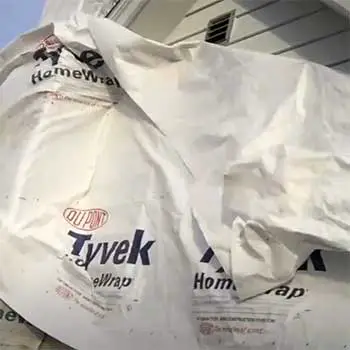You are looking for a comprehensive comparison between Rex-Wrap and Tyvek house wrap because deciding between the two is confusing. Well, you are in the right place.
I’ve discussed these two in detail with professionals’ opinions and my own experience.
Rex-Wrap is a woven weather-resistant breather, whereas Tyvek is a non-woven house wrap. Besides, Rex-Wrap weighs 2.2 oz. Per sq. yard, but Tyvek weighs 1.8 oz. Per sq. yard.
Apart from those, there are many differences that you must know to choose the right product correctly. So, let’s start the tour.
A Quick Comparison Table
Here is a quick comparison table between Rex-Wrap and Tyvek House Wraps:
| Aspects | Rex-Wrap | Tyvek |
| Product Type | Woven Weather-Resistant Breather | Non-Woven House Wrap |
| Key Features and Benefits | Offers Fewer Features & Benefits | Offers More Features & Benefits |
| Weight & Coverage | 2.2 OZ. Per Sq. Ft. Max 1500 Sq. Ft. | 1.8 OZ. Per Sq. Ft. Max 1950 Sq. Ft. |
| Warranty | 25 Year Warranty | 10 Year Limited Warranty |
| Longevity | 10-12 years | 10-15 years |
In-Depth Comparisons Between Rex-Wrap And Tyvek House Wrap

Now I will show you some key differences between the two of them. This is not just my opinion; I’m writing this after consulting with my fellow professionals and many customer reviews. So, let’s dive in.
- Product Type
Rex-Wrap is a high-quality weather-resistant breather house wrap made of woven and polypropylene coating.
It will protect your home from air and moisture.
Because of its unique micro-perforation, air and moisture vapor can escape from your wall.
As a result, moisture won’t be able to condensate inside the walls. Rex-Wrap will also protect your walls from outside harmful elements.
On the contrary, Tyvek HouseWrap is a non-woven house wrap that allows moisture vapor to escape and keeps air and water out at the same time. Thus it will protect your house from wind and rain damage and make it long-lasting.
My experience with Tyvek shows that it insulates the home pretty well and controls the inflow and outflow of air and temperature. So, you can reduce your electricity bills by wrapping your home with Tyvek.
- Key Features and Benefits

You will get professional-level features and benefits from Rex-Wrap.
Its primary objective is to protect your home from water and air intrusion.
At the same time, it takes out the moisture vapor from the wall cavity and keeps it protected for a long time.
Because of the tear resistance, you will have very little wastage and blow-offs while installing them. Besides, this sheet will protect your home from UV rays for up to 6 months of direct sunlight exposure.
Custom printing design in your Rex-Wrap sheet for as low as 1 pallet is a unique benefit that you’ll enjoy only from Rex-Wrap.
On the other hand, Tyvek House Wrap is exceptionally lightweight and comparatively easy to handle. You can install this cost-effective weather sheet fast and efficiently.
With great control of airflow and water intrusion, you will get a warmer home in the winter, cooler in the summer, and dry.
This breathable formula can insulate your house pretty well. So, you will have less electricity consumption for climate control resulting in less energy bills.
- Ease of Installation
Installing house wrap properly is critical to realizing its moisture and air sealing benefits. In general, Rex-Wrap tends to have a leg up over Tyvek for easier installation:

- Rex-Wrap’s polypropylene fabric facing resists tearing if mishandled during installation. It cuts easily and neatly with utility knives.
- Tyvek is prone to ripping and mangling if not handled carefully. The spunbonded material does not cut as cleanly. Installers must take care not to damage it.
- Rex-Wrap allows secure sealing with standard tapes. Tyvek often requires specialized tapes for the best adhesion.
- Rex-Wrap’s greater flexibility makes wrapping complex geometries, curves, and corners simpler. Stiff Tyvek sheets can be more difficult to work in these areas.
An experienced builder or installer will get great results from both products when applied correctly. But Rex-Wrap is generally more forgiving and straightforward for DIYers and less-skilled crews. This can help avoid expensive repairs from improper installation.
- Durability and Longevity
How long should a quality house wrap last once installed? Both Rex-Wrap and Tyvek should provide 10-15 years of effective weather protection:
- Rex-Wrap warranties typically guarantee 10-12 years of durability when used under normal conditions.
- Tyvek warranties extend to 10-15 years based on the specific product grade and exposure levels.
To maximize lifespan:
- Install house wrap according to manufacturer guidelines
- Avoid unnecessary UV exposure during construction
- Use compatible fasteners, tapes, and adhesives
- Repair any tears or gaps immediately
With proper installation and care, Rex-Wrap and Tyvek wraps will both effectively protect your home’s envelope for well over a decade before needing replacement.
- Weight & Coverage

Both Rex-Wrap and Tyvek HouseWrap are incredibly lightweight.
But Tyvek is lighter than Rex-Wrap with a 1.8 oz. per square yard weight.
Conversely, Rex-Wrap weighs 2.2 oz. per square yard.
Talking of coverage, 3 feet by 100 feet is the smallest roll of Tyvek that covers 300 square feet of walls.
The max size is 10 feet by 150 feet with a 1500 feet coverage.
By contrast, Rex-Wrap offers many smaller width options like 54 inches by 100 feet. But the maximum roll size is 10 feet by 195 feet which covers 1950 square feet.
- Warranty
Rex-Wrap comes with a 25 Year Warranty. You will get a 10 Year Product Only Limited Warranty and a 25 Years Product and Labor Limited Warranty.
On the contrary, Tyvek House Wrap has a 10 Year Product and Labor Limited Warranty. As we can see, Rex-Wrap is better warranted from its manufacturer than Tyvek.
- Price
When comparing Rex-Wrap vs Tyvek on price, Tyvek tends to be a bit more expensive:
- Rex-Wrap house wrap costs $100-150 for a 5×100 ft roll.
- Tyvek HouseWrap runs $130-180+ for a 5×100 ft roll.
Of course, pricing can vary by specific type and manufacturer. But in general, Tyvek is around 25% more expensive than comparable Rex-Wrap products.
One thing to note is that the pricing difference gets smaller when comparing high-end specialty wraps designed for specific climates. For example, Tyvek ThermaWrap LE is only about 15% more than equivalent Rex-Wrap products.
Still, Rex-Wrap gives you reliable performance for the best value overall. Just ensure any cheaper house wrap alternatives you consider meet all the proper testing and certification standards that Rex-Wrap and Tyvek meet.
Rex-Wrap and Tyvek Installation Best Practices
To finish our comparison, let’s overview some best practices for installing Rex-Wrap or Tyvek properly:
- Start with a smooth, continuous substrate like exterior rigid foam or plywood sheathing.
- Use compatible, UV-resistant fasteners spaced 12-18 inches apart around the perimeter and throughout the field.
- Overlap horizontal seams at least 6 inches and vertical seams by at least 12 inches.
- Tape all seams using manufacturer recommended tape (typically 3-4 inch for Tyvek, 2-3 inch for Rex-Wrap).
- Avoid unnecessary punctures and damage during installation and exterior finish application.
- Seal wraps fully around all penetrations like windows, doors, and utilities.
- Follow all manufacturer guidelines for proper installation in your climate and region.
Proper installation is crucial to realizing the full benefits these wraps provide. Take the time to carefully apply the house wrap with good overlaps, taping, fastening, and detailing.
Which House Wrap is Best For You?

Now that we’ve compared Rex-Wrap and Tyvek’s performance, cost, installation, and durability, how do you decide which is better for your home?
Here are a few key factors to consider when choosing one over the other:
- Budget – If keeping material costs down is crucial, Rex-Wrap provides the best value and performance for the price.
- Ease of Installation – For DIYers or less-skilled crews, Rex-Wrap’s greater flexibility and tear resistance make it the easier product to install successfully.
- Specialized Weather Protection Needs – For extreme climates or conditions, upgraded specialty wraps like Tyvek ThermaWrap may provide enhanced protection.
- Existing Home vs. New Construction – For renovating older homes, Rex-Wrap’s simpler installation often works best. Newer construction can utilize either product effectively.
- Contractor Preference – Some contractors vastly prefer one product over another based on familiarity and experience. This can factor into the decision as well.
For many homeowners and builders, Rex-Wrap provides the optimal balance of affordability, weather protection, and installability. But there are certainly situations where opting for Tyvek over Rex-Wrap makes sense.
Carefully weigh your specific needs, climate, budget, and project scope before deciding.
Frequently Asked Questions (FAQ)
Rex-Wrap is a lightweight woven weather breathing house wrap. It can protect your home from air and water intrusion and protects your walls from moisture building.
Tyvek is an excellent non-woven house wrap that can insulate your home and protect it from air and water. But Typar Building Wrap and Barricade Building Wrap are better than Tyvek.
Non-woven house wrap with asphalt felt paper is the best quality house wrap for professional-grade performance. Tyvek HomeWrap is also a pretty good option that many professionals use.
Rex-Wrap is a woven sheet with polypropylene coating. It prevents water and air from infiltrating your wall and prevents moisture build-up at the same time.
Final Thoughts
After reading this Rex-Wrap and Tyvek House Wrap review, you’ve found the best option among these two house wraps. Since insulating your house and protecting it from air and water intrusion is essential, you must use the best product available.
Now that you know that Tyvek will be the best option for your building, I highly suggest using this product.

Ralph,
Which product of Rex are you comparing? Rex wrap woven or Rex wrap Fortis non woven? Your picture of Rex is the Fortis version and is nonwoven not a woven.
Bill